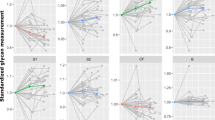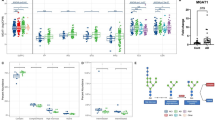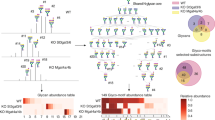Abstract
Classical galactosaemia (OMIM #230400), a rare disorder of carbohydrate metabolism, is caused by a deficient activity of galactose-1-phosphate uridyltransferase (EC 2.7.7.12). The pathophysiology of the long-term complications, mainly cognitive, neurological and female fertility problems remains poorly understood. The lack of validated biomarkers to determine prognosis, monitor disease progression and responses to new therapies, pose a huge challenge. We report the detailed analysis of an automated robotic hydrophilic interaction ultra-performance liquid chromatography N-glycan analytical method of high glycan peak resolution applied to serum IgG. This has revealed specific N-glycan processing defects observed in 40 adult galactosaemia patients (adults and adolescents), in comparison with 81 matched healthy controls. We have identified a significant increase in core fucosylated neutral glycans (P<0.0001) and a significant decrease in core fucosylated (P<0.001), non-fucosylated (P<0.0001) bisected glycans and, of specific note, decreased N-linked mannose-5 glycans (P<0.0001), in galactosaemia patients. We also report the abnormal expression of a number of related relevant N-glycan biosynthesis genes in peripheral blood mononuclear cells from 32 adult galactosaemia patients. We have noted significant dysregulation of two key N-glycan biosynthesis genes: ALG9 upregulated (P<0.001) and MGAT1 downregulated (P<0.01) in galactosaemia patients, which may contribute to its ongoing pathophysiology. Our data suggest that the use of IgG N-glycosylation analysis with matched N-glycan biosynthesis gene profiles may provide useful biomarkers for monitoring response to therapy and interventions. They also indicate potential gene modifying steps in this N-glycan biosynthesis pathway, of relevance to galactosaemia and related N-glycan biosynthesis disorders.
Similar content being viewed by others
Log in or create a free account to read this content
Gain free access to this article, as well as selected content from this journal and more on nature.com
or
References
Hughes J, Ryan S, Lambert D et al: Outcomes of siblings with classical galactosemia. J Pediatr 2009; 154: 721–726.
Krabbi K, Uudelepp M-L, Joost K, Zordania R, Ounap K : Long-term complications in Estonian galactosemia patients with a less strict lactose-free diet and metabolic control. Mol Genet Metab 2011; 103: 249–253.
Fridovich-Keil J, Walter J : Galactosaemia. In: Valle D (ed): The Online Metabolic and Molecular Bases of Inherited Disease, OMMBID. New York, USA: The McGraw-Hill Companies, Inc., 2008.
Frey PA : The Leloir pathway: a mechanistic imperative for three enzymes to change the stereochemical configuration of a single carbon in galactose. FASEB J 1996; 10: 461–470.
Dani N, Broadie K : Glycosylated synaptomatrix regulation of trans‐synaptic signaling. Dev Neurobiol 2012; 72: 2–21.
Liu Y, Xia B, Gleason TJ et al: N-and O-linked glycosylation of total plasma glycoproteins in galactosemia. Mol Genet Metab 2012; 106: 442–454.
Jumbo-Lucioni P, Parkinson W, Broadie K : Altered synaptic architecture and glycosylated synaptomatrix composition in a Drosophila classic galactosemia disease model. Dis Model Mech 2014; 7: 1365–1378.
Freeze HH : Understanding human glycosylation disorders: biochemistry leads the charge. J Biol Chem 2013; 288: 6936–6945.
Arnold JN, Saldova R, Galligan MC et al: Novel glycan biomarkers for the detection of lung cancer. J Proteome Res 2011; 10: 1755–1764.
Youings A, Chang S, Dwek R, Scragg I : Site-specific glycosylation of human immunoglobulin G is altered in four rheumatoid arthritis patients. Biochem J 1996; 314: 621–630.
Thanabalasingham G, Huffman JE, Kattla JJ et al: Mutations in HNF1A result in marked alterations of plasma glycan profile. Diabetes 2013; 62: 1329–1337.
Royle L, Radcliffe CM, Dwek RA, Rudd PM : Detailed structural analysis of N-glycans released from glycoproteins in SDS-PAGE gel bands using HPLC combined with exoglycosidase array digestions; In Brockhausen I ed: Glycobiology Protocols. Totowa, NJ, USA: Humana Press Inc., 2007, Vol 347 pp 125–143.
Royle L, Campbell MP, Radcliffe CM et al: HPLC-based analysis of serum N-glycans on a 96-well plate platform with dedicated database software. Anal Biochem 2008; 376: 1–12.
Knezevic A, Polasek O, Gornik O et al: Variability, heritability and environmental determinants of human plasma N-glycome. J Proteome Res 2008; 8: 694–701.
Huhn C, Selman MH, Ruhaak LR, Deelder AM, Wuhrer M : IgG glycosylation analysis. Proteomics 2009; 9: 882–913.
Kanda Y, Yamada T, Mori K et al: Comparison of biological activity among nonfucosylated therapeutic IgG1 antibodies with three different N-linked Fc oligosaccharides: the high-mannose, hybrid, and complex types. Glycobiology 2007; 17: 104–118.
Sturiale L, Barone R, Fiumara A et al: Hypoglycosylation with increased fucosylation and branching of serum transferrin N-glycans in untreated galactosemia. Glycobiology 2005; 15: 1268–1276.
Charlwood J, Clayton P, Keir G, Mian N, Winchester B : Defective galactosylation of serum transferrin in galactosemia. Glycobiology 1998; 8: 351–357.
Coman DJ, Murray DW, Byrne JC et al: Galactosemia, a single gene disorder with epigenetic consequences. Pediatr Res 2010; 67: 286–292.
Coss K, Byrne J, Coman D et al: IgG N-glycans as potential biomarkers for determining galactose tolerance in Classical Galactosaemia. Mol Genet Metab 2012; 105: 212–220.
Coss K, Treacy E, Cotter E et al: Systemic gene dysregulation in classical galactosaemia: is there a central mechanism? Mol Genet Metab 2014; 113: 177–187.
Freeze HH : Genetic defects in the human glycome. Nat Rev Genet 2006; 7: 537–551.
Ornstein K, McGuire E, Berry G, Roth S, Segal S : Abnormal galactosylation of complex carbohydrates in cultured fibroblasts from patients with galactose-1-phosphate uridyltransferase deficiency. Pediatr Res 1992; 31: 508–511.
Ng W, Xu Y, Kaufman F, Donnell G : Deficit of uridine diphosphate galactose in galactosaemia. J Inherit Metab Dis 1989; 12: 257–266.
Lai K, Langley S, Khwaja F, Schmitt E, Elsas L : GALT deficiency causes UDP-hexose deficit in human galactosemic cells. Glycobiology 2003; 13: 285–294.
Slepak TI, Tang M, Slepak VZ, Lai K : Involvement of endoplasmic reticulum stress in a novel Classic Galactosemia model. Mol Genet Metab 2007; 92: 78–87.
Petry K, Greinix HT, Nudelman E et al: Characterization of a novel biochemical abnormality in galactosemia: deficiency of glycolipids containing galactose or N-acetylgalactosamine and accumulation of precursors in brain and lymphocytes. Biochem Med Metab Biol 1991; 46: 93–104.
Coss KP, Hawkes CP, Adamczyk B et al: N-glycan abnormalities in children with galactosemia. J Proteome Res 2013; 13: 385–394.
Knerr I, Coss KP, Kratzsch J et al: Effects of temporary low-dose galactose supplements in children aged 5-12 y with classical galactosemia: a pilot study. Pediatr Res 2015; 78: 272–279.
Hutcheson A, Murdoch-Davis C, Green A et al: Biochemical monitoring of treatment for galactosaemia: biological variability in metabolite concentrations. J Inherit Metab Dis 1999; 22: 139–148.
Bosch A, Bakker H, de B Wenniger-Prick L, Wanders R, Wijburg F : High tolerance for oral galactose in classical galactosaemia: dietary implications. Arch Dis Child 2004; 89: 1034–1036.
Stöckmann H, Adamczyk B, Hayes J, Rudd PM : Automated, high-throughput IgG-antibody glycoprofiling platform. Anal Chem 2013; 85: 8841–8849.
Stockmann H, Coss KP, Rubio-Gozalbo ME et al: IgG N-glycosylation galactose incorporation ratios for the monitoring of classical galactosaemia; JIMD Reports Germany: Springer Berlin Heidelberg, 2015.
Pučić M, Knežević A, Vidič J et al: High throughput isolation and glycosylation analysis of IgG–variability and heritability of the IgG glycome in three isolated human populations. Mol Cell Proteomics 2011; 10: 1–15.
Rendić D, Sharrow M, Katoh T et al: Neural-specific α3-fucosylation of N-linked glycans in the Drosophila embryo requires fucosyltransferase A and influences developmental signaling associated with O-glycosylation. Glycobiology 2010; 20: 1353–1365.
Seko A, Yamashita K: Map 1: biosynthetic pathways of N-glycans. In: Naoyuki Taniguchi KH, Fukuda Minoru, Narimatsu Hisashi, Yamaguchi Yoshiki, Angata Takashied): Handbook of Glycosyltransferases and Related Genes. Japan: Springer, 2014, 2nd edn, pp 1659–1665.
Frank CG, Eyaid W, Berger EG, Aebi M, Grubenmann CE, Hennet T : Identification and functional analysis of a defect in the human ALG9 gene: definition of congenital disorder of glycosylation type IL. Am J Hum Genet 2004; 75: 146–150.
Aebi M : N-linked protein glycosylation in the ER. Biochim Biophys Acta 2013; 1833: 2430–2437.
Pownall S, Kozak CA, Schappert K et al: Molecular cloning and characterization of the mouse UDP-N-acetylglucosamine: α-3-D-mannoside β-1, 2-N-acetylglucosaminyltransferase I gene. Genomics 1992; 12: 699–704.
Ye Z, Marth JD : N-glycan branching requirement in neuronal and postnatal viability. Glycobiology 2004; 14: 547–558.
Shi S, Williams SA, Seppo A et al: Inactivation of the Mgat1 gene in oocytes impairs oogenesis, but embryos lacking complex and hybrid N-glycans develop and implant. Mol Cell Biol 2004; 24: 9920–9929.
Campbell RM, Metzler M, Granovsky M, Dennis JW, Marth JD : Complex asparagine-linked oligosaccharides in Mgat1-null embryos. Glycobiology 1995; 5: 535–543.
Grasa P, Kaune H, Williams SA : Embryos generated from oocytes lacking complex N-and O-glycans have compromised development and implantation. Reproduction 2012; 144: 455–465.
Schachter H, Boulianne G : Life is sweet! A novel role for N-glycans in Drosophila lifespan. Fly (Austin) 2011; 5: 18–24.
Sarkar M, Iliadi KG, Leventis PA, Schachter H, Boulianne GL : Neuronal expression of Mgat1 rescues the shortened life span of Drosophila Mgat11 null mutants and increases life span. Proc Natl Acad Sci USA 2010; 107: 9677–9682.
Acknowledgements
Funding for these studies was granted by the Irish Medical Research Charities Group/Health Research Board, Ireland (MRCG-HRB/CFFH (Temple St Childrens University Hospital). HS was supported by the EU FP7 Research Framework Program ‘High Glycan’ (grant reference no. 278535).
Author information
Authors and Affiliations
Corresponding author
Ethics declarations
Competing interests
The authors declare no conflict of interest.
Additional information
Supplementary Information accompanies this paper on European Journal of Human Genetics website
Supplementary information
Rights and permissions
About this article
Cite this article
Maratha, A., Stockmann, H., Coss, K. et al. Classical galactosaemia: novel insights in IgG N-glycosylation and N-glycan biosynthesis. Eur J Hum Genet 24, 976–984 (2016). https://doi.org/10.1038/ejhg.2015.254
Received:
Revised:
Accepted:
Published:
Issue date:
DOI: https://doi.org/10.1038/ejhg.2015.254
This article is cited by
-
Multi-block data integration analysis for identifying and validating targeted N-glycans as biomarkers for type II diabetes mellitus
Scientific Reports (2022)
-
Sialylated N-glycan profile during acute and chronic infections with Toxoplasma gondii in mice
Scientific Reports (2020)
-
Identification of serum N-glycoproteins as a biological correlate underlying chronic stress response in mice
Molecular Biology Reports (2019)
-
Fertility in classical galactosaemia, a study of N-glycan, hormonal and inflammatory gene interactions
Orphanet Journal of Rare Diseases (2018)
-
Impaired fertility and motor function in a zebrafish model for classic galactosemia
Journal of Inherited Metabolic Disease (2018)



